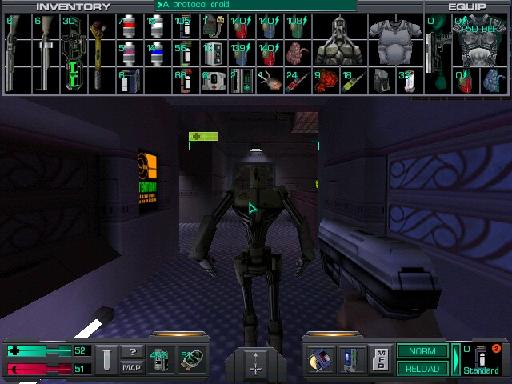System Shock 2
System Shock 2 is a 1999 first-person action role-playing video game, designed by Ken Levine for Microsoft Windows. The title is a sequel to the 1994 PC game System Shock, and was co-developed by Irrational Games and Looking Glass Studios. The sequel was originally designed as a standalone title with no relation to System Shock; story changes were made when Electronic Arts—who owned the Shock franchise rights—signed on as publisher. System Shock 2 was released on August 11, 1999 in North America.
The game takes place on board a starship in a cyberpunk depiction of 2114. The player assumes the role of a lone soldier trying to stem the outbreak of a genetic infection that has devastated the ship. Like System Shock, gameplay consists of first person shooting and exploration. The game also incorporates role-playing system elements, where the player can develop unique skills and traits, such as hacking and psionic abilities.
System Shock 2 received positive reviews when released, but failed to meet commercial sales expectations. In retrospect, many critics have determined the game to be highly influential, particularly on first person shooters, and far ahead of its time, and inducted it into several "greatest games of all time" lists. In January 2006, Computer and Video Games reported System Shock 3 may be under development. As of January 2009, nothing conclusive has surfaced regarding the purported project's status. In 2007, Irrational—then 2K Boston/2K Australia—released a self-proclaimed 'spiritual successor' to the System Shock series, entitled BioShock, to critical acclaim and strong sales.
Gameplay:
Like its predecessor, gameplay in System Shock 2 is an amalgamation of the role-playing game (RPG) and first person shooter (FPS) genres. The player uses melee and projectile weapons to defeat enemies, while a role-playing system allows the development of useful abilities. Navigation is presented from a first-person perspective and complemented with aheads-up display that shows character and weapon information, a map, and a drag and drop inventory. Backstory is explained progressively through the acquisition of audio logs and encounters with ghostly apparitions.
The game begins with the player choosing a career in a branch of the Unified National Nominate, a fictional military organization. Each branch of service gives the player a set of starting bonuses in certain skills, though he may thereafter freely develop himself as he pleases. Marines begin with bonuses to weaponry, Navy officers are trained in repairing and hacking, and OSA agents get a starting set of psionic powers.
The player can upgrade his skills by spending "cyber-modules", which are obtained as rewards for completing objectives or searching every nook and cranny of the ship. Skills are enhanced by spending cyber-modules at devices called "cyber-upgrade units" O/S units allow special one-time character upgrades to be made (e.g. permanent health enhancement).
An in-game currency, called "nanites", may be spent on items at vending machines. This includes ammunition supplies and health packs. "Quantum Bio-Reconstruction Machines" can be activated and reconstitute the player for 10 "nanites" if they die in the same area. Otherwise, the game ends and progress must be resumed from a save point.
The player can hack devices, such as keypads to open alternate areas and vending machines to reduce prices. When a hack is attempted, a minigame begins where a grid of green nodes form; the player must connect three in a straight row to succeed. Optionally, electronic lock picks can be found and automatically hack a machine, regardless of its difficulty.
Various weapons can be procured throughout the game, including melee weapons, pistols, shotguns, and alien weapons. Non-melee weapons degrade with use and will break if they are not regularly repaired with maintenance tools. Different ammunition types exist which are more effective to susceptible enemies. For example, organic enemies are vulnerable toanti-personnel rounds, while mechanical foes are weak against armor-piercing rounds. Because ammunition is scarce, the player must use it sparingly and carefully search rooms for supplies.
The game also includes a research function. When new objects are encountered in the game, especially enemies, their organs can be collected. Combined with chemicals found in storage rooms, the player can research the enemies and improve their damage against them.
OSA agents effectively have a separate weapons tree available to them. Psionic powers can be learned, such as invisibility, fireballs and teleportation.
SYSTEM REQUIREMENTS:
MINIMUM PC REQUIREMENTS Minimum CPU Type: PentiumMinimum CPU Speed: 200 MHzMinimum RAM Required: 32 MBMinimum Hard Disk Space: 200 MBGraphics Type: SVGAGraphics Resolution: Multiple ResolutionsColor Depth: True

















No comments:
Post a Comment